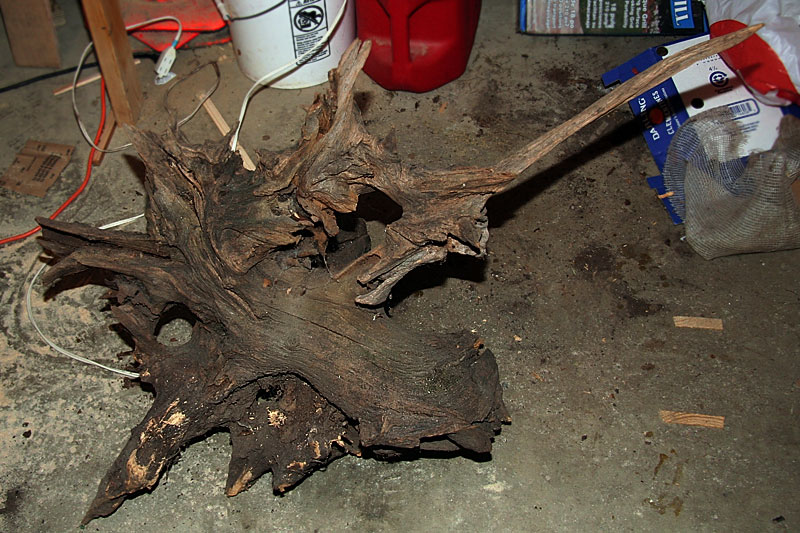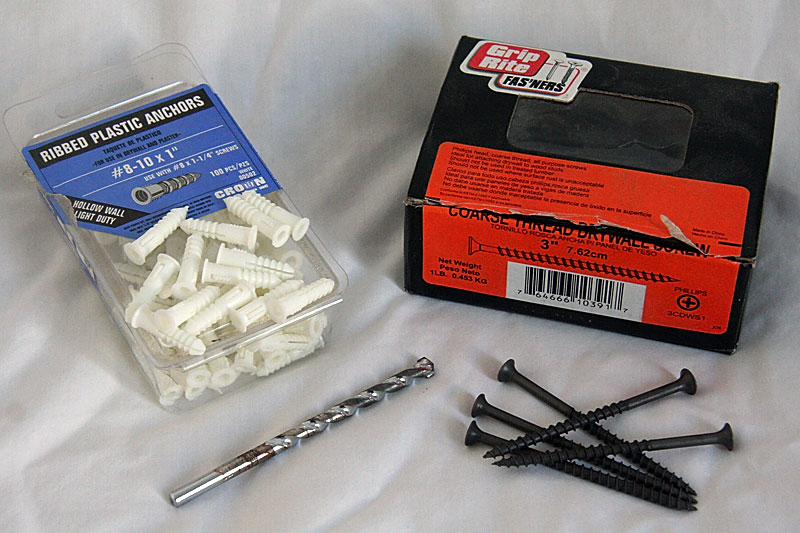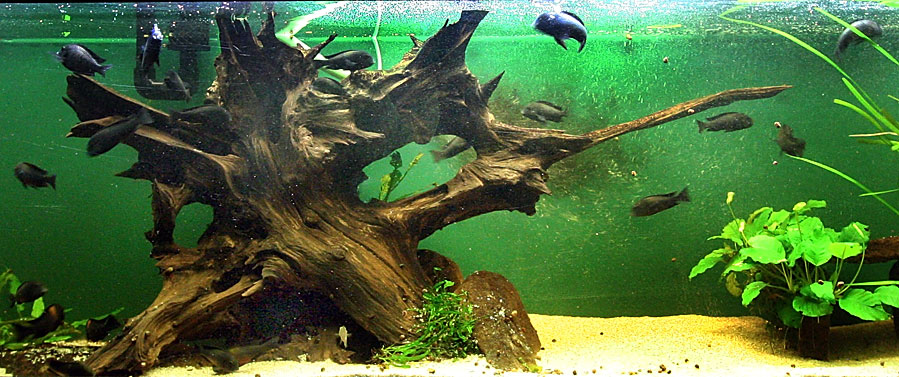Wood
 A huge piece of wood is the central decoration item in my 125G tropheus tank.
Lake Tanganyika, where the fish in this tank come from, contains only negligible amounts of driftwood, and its fish are not used to appreciable concentrations of tannins and humic acids in the water. Tropheus have a reputation of being particularly sensitive to water parameters, but I believe that at least for tank raised individuals this isn't really true - although there can be no doubt that these fish demand absolutely pristine water quality! Wood in the water can have an impact on both - water parameters by lowering pH, and water quality if it rots and raises ammonia, nitrite and nitrate. However, as long as you keep up with regular water changes - in this tank taken care of by a CAWC system - the former effect will be minimal, and the latter can be completely prevented.
I had found the piece of wood that was used to decorate this 125G tropheus tank in the forest some time before I set up the tank. Ever since I was a kid, I have always kept an eye open for unusually shaped roots or pieces of wood that could be used for some kind of project - be it a building a raft for my Playmobil people, making a flower arrangement, or decorating my turtle and fish tanks. When I saw the piece that is pictured above, I instantly knew that I had found a keeper, even though it took me some time of actually having it in the tank before I really knew how unique this piece is. The photos really don't do it justice, since it is shaped like a Swiss cheese - there are holes and tunnels in it, which give little fry a chance to hide from adult fish and only come out once they are old enough to no longer appear as easy prey. When doing water changes, I can actually hold a hose at entries on top of the log, and stir up sand in certain places underneath - the holes go right through the entire log!
When I first saw this root, it was actually still attached to a sizable trunk. I had to plan an outing and take a saw along in order to cut it loose. I also hugely underestimated its weight, but I luckily had a dog leach with me that I could sling through the big hole on the left, allowing me to carry some of the weight on my shoulder when lugging the thing back to the car.
As you can see in the following picture, the wood only just fits in the tank with respect to its height. In fact, I had to make it fit by sawing off some parts. Naturally I did this on the part of the wood that became the bottom, so the saw marks are now invisible.
A huge piece of wood is the central decoration item in my 125G tropheus tank.
Lake Tanganyika, where the fish in this tank come from, contains only negligible amounts of driftwood, and its fish are not used to appreciable concentrations of tannins and humic acids in the water. Tropheus have a reputation of being particularly sensitive to water parameters, but I believe that at least for tank raised individuals this isn't really true - although there can be no doubt that these fish demand absolutely pristine water quality! Wood in the water can have an impact on both - water parameters by lowering pH, and water quality if it rots and raises ammonia, nitrite and nitrate. However, as long as you keep up with regular water changes - in this tank taken care of by a CAWC system - the former effect will be minimal, and the latter can be completely prevented.
I had found the piece of wood that was used to decorate this 125G tropheus tank in the forest some time before I set up the tank. Ever since I was a kid, I have always kept an eye open for unusually shaped roots or pieces of wood that could be used for some kind of project - be it a building a raft for my Playmobil people, making a flower arrangement, or decorating my turtle and fish tanks. When I saw the piece that is pictured above, I instantly knew that I had found a keeper, even though it took me some time of actually having it in the tank before I really knew how unique this piece is. The photos really don't do it justice, since it is shaped like a Swiss cheese - there are holes and tunnels in it, which give little fry a chance to hide from adult fish and only come out once they are old enough to no longer appear as easy prey. When doing water changes, I can actually hold a hose at entries on top of the log, and stir up sand in certain places underneath - the holes go right through the entire log!
When I first saw this root, it was actually still attached to a sizable trunk. I had to plan an outing and take a saw along in order to cut it loose. I also hugely underestimated its weight, but I luckily had a dog leach with me that I could sling through the big hole on the left, allowing me to carry some of the weight on my shoulder when lugging the thing back to the car.
As you can see in the following picture, the wood only just fits in the tank with respect to its height. In fact, I had to make it fit by sawing off some parts. Naturally I did this on the part of the wood that became the bottom, so the saw marks are now invisible.
 A huge piece of wood for my 125G tank, here still sitting in my garage.
Since putting a preview of the 125G up on this web site, everybody has been asking me what to look for one when using wood from the forest in a fish tank, and how to treat the stuff. That's why I wrote up the following article on:
A huge piece of wood for my 125G tank, here still sitting in my garage.
Since putting a preview of the 125G up on this web site, everybody has been asking me what to look for one when using wood from the forest in a fish tank, and how to treat the stuff. That's why I wrote up the following article on:
Collecting wood for aquarium decorations and how to treat it
What I look for is wood that looks old and weathered, but is still hard. If it is kinda mushy and crumbly, it will rot quickly in a tank, and foul the water. If the wood is nice and hard, you can keep it in a tank for years and not have problems. I've had pieces that I found here in Ohio in tanks for close to four years, and they still look great. Java fern really loves to grow on this stuff, and seems to take root a lot easier than for example on rock. I use a brush and a big screwdriver to remove all loose bits from the wood before I put it in a tank. I never boil it. I've read that boiling will actually lead to the wood rotting quicker in a tank, but I don't know if that's true. At any rate, boiling in my experience isn't necessary. There will be no fish diseases in a piece of wood that's been lying in the forest far away from any waterway that's inhabited by fish! Mind you, I have also used wood that I found near the Cuyahoga River. That might be bit more risky, but I reckon your odds of getting away with this unscathed are far better than when you introduce fish from a chain store without quarantining them! If there really is a little worm still crawling out of the wood, your fish will probably consider it a tasty treat! Case in point, several weeks after I put this huge piece of driftwood in my 125G and added the tropheus, one day I found the tropheus pushing a dark brown, cigar shaped, about 2" long object around in the tank. It turned out the cocoon of some insect larva that must have been hiding in a crevice somewhere in the wood. Since it was bigger than any of the tropheus at the time, they would have never been able to eat it, and I simply removed it, but I am sure the tropheus enjoyed the distraction! Newly set up tank, no fish added yet. You can see two of the three rocks that are used to weigh the wood down - a big flat one on the left, and a smaller one standing up on the right.
If you can soak the wood before putting it in a tank, that might be a plus, because my wood always browns the water quite a bit in the beginning. However, frequent water changes and, if required, filtration via carbon will get rid of this problem within a few weeks. For a piece of wood to become so waterlogged that it will sink by itself it can take a long time though. I had pieces in a 29G tank that stayed down after 6 months, but I also have one in my 75G that needed two years before it stayed down without a big rock on one end. Mostly these days I attach rocks to the wood permanently, incorporating both wood and rock into my aquascaping. That way I can install a piece of wood immediately and never have to worry about it again. For most pieces of wood only one rock is required, but the monster piece in the 125G you see here weighs 28 pounds (12.6kg) dry, so I actually worked up a bit of sweat lugging it back to the car! To hold it down, it has 3 pieces of Ohio top rock (sandstone) weighing a total 34 pounds (15.4kg) attached to it using 3" drywall screws. This is the same type of rock I am using for the background in my 240G tank, and it can be drilled very easily using a masonry bit. The screws can go through the rock into the wood, or through the wood into a plastic dowel that sits in the rock. It's very easy to do, gives a very natural look when complete, and you don't need the laborious curing process that people need to use when anchoring wood in concrete - concrete initially leaches harmful chemicals in the water, sandstone doesn't.
Newly set up tank, no fish added yet. You can see two of the three rocks that are used to weigh the wood down - a big flat one on the left, and a smaller one standing up on the right.
If you can soak the wood before putting it in a tank, that might be a plus, because my wood always browns the water quite a bit in the beginning. However, frequent water changes and, if required, filtration via carbon will get rid of this problem within a few weeks. For a piece of wood to become so waterlogged that it will sink by itself it can take a long time though. I had pieces in a 29G tank that stayed down after 6 months, but I also have one in my 75G that needed two years before it stayed down without a big rock on one end. Mostly these days I attach rocks to the wood permanently, incorporating both wood and rock into my aquascaping. That way I can install a piece of wood immediately and never have to worry about it again. For most pieces of wood only one rock is required, but the monster piece in the 125G you see here weighs 28 pounds (12.6kg) dry, so I actually worked up a bit of sweat lugging it back to the car! To hold it down, it has 3 pieces of Ohio top rock (sandstone) weighing a total 34 pounds (15.4kg) attached to it using 3" drywall screws. This is the same type of rock I am using for the background in my 240G tank, and it can be drilled very easily using a masonry bit. The screws can go through the rock into the wood, or through the wood into a plastic dowel that sits in the rock. It's very easy to do, gives a very natural look when complete, and you don't need the laborious curing process that people need to use when anchoring wood in concrete - concrete initially leaches harmful chemicals in the water, sandstone doesn't.
 Masonry drill bit, plastic anchors, and drywall screws.
Regarding the type of wood, I do not think I've ever found a piece from a needle tree, like pine, spruce or fir, that was weathered and still hard. I reckon these trees have lighter, softer wood that rots quicker. Leaf trees seems to do much better in that regard, and I really don't think it matters much which one you choose. I am not aware of any that wouldn't work at all.
Masonry drill bit, plastic anchors, and drywall screws.
Regarding the type of wood, I do not think I've ever found a piece from a needle tree, like pine, spruce or fir, that was weathered and still hard. I reckon these trees have lighter, softer wood that rots quicker. Leaf trees seems to do much better in that regard, and I really don't think it matters much which one you choose. I am not aware of any that wouldn't work at all.
 The big piece of driftwood after about one year in the tank. The tropheus keep it very clean of algae!
The big piece of driftwood after about one year in the tank. The tropheus keep it very clean of algae!
Leave a Reply
You must be logged in to post a comment.
